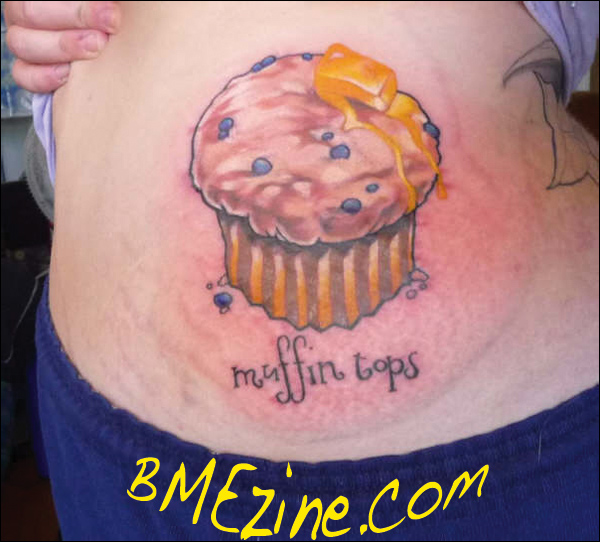
(This marvelous muffin top is courtesy of Alissa.)
UPDATE: Definitely forgot to add the contextual photo. Zoom out, after the jump:
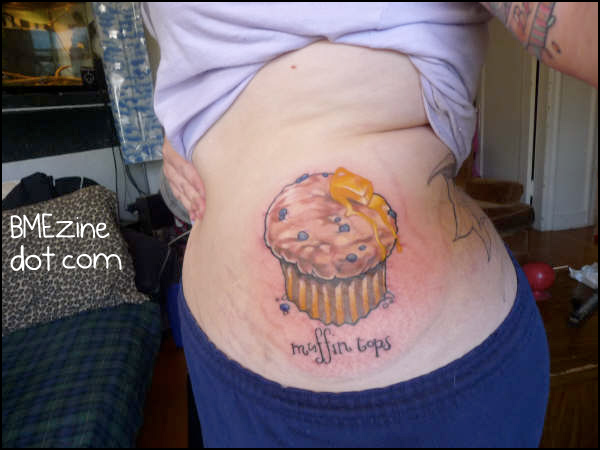

(This marvelous muffin top is courtesy of Alissa.)
UPDATE: Definitely forgot to add the contextual photo. Zoom out, after the jump:

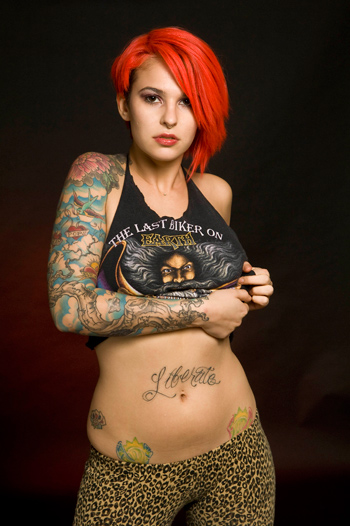 |
| © Markus Cuff Photo 2009 |
Markus Cuff has been cooperative so far, but now he’s stiff-arming me. We’ve been on the phone for a good half-hour or so, having a perfectly pleasant conversation about his 15 years as one of the top photographers at Tattoo magazine, and now this? He gives me the high-hat over a harmless, standard interview question?
“How old are you?” I ask with my typical childlike sweetness and wonder.
“I’m, uh….” He stops himself short. What have you got to hide, Cuff? “I’m 103,” he finally says. “My age is a closely guarded secret.”
“You can be vague,” I tell him. “Just say you’re ‘something-ish.’”
“‘Something-ish,’” he repeats, and pauses again. “A hundred and three.”
Whatever, wise guy. I’m only asking because his story makes it seem like he’s lived through (and contributed to) a number of seminal cultural moments, and these life experiences just seem a little incongruous with his lively, almost boyish voice. But, sure…103.
What he tells me is by the time he got around to photography, he already felt like he was late to the game. If he’d started in earnest as a teenager, he could have been going to concerts and shooting bands like Led Zeppelin and Cream, guys like Jimi Hendrix and Stevie Ray Vaughn, and maybe he could published a retrospective book by now, making money off portraits of rock gods. He saw others go that route, but while his potential peers were chasing fame as photographers, Cuff, the boy from suburban Maryland, home of Link Wray, took a detour and made a name for himself as a musician instead. He spent two years handling the drum kit for Emmylou Harris’s band, touring and playing on her Pieces of the Sky album. Some time in the late seventies/early eighties, he moved to Los Angeles and ended up playing in The Textones with Carla Olson and Kathy Valentine (the latter of whom would go on to join The Go-Gos), hitting the L.A. club circuit with bands like X and The Blasters.
It was there in L.A., though, that he made friends with some kids who were taking photo classes at Santa Monica College, and Cuff, who had once long ago learned how to develop prints from black and white film, felt that old passion start to warm. “I looked at their work,” he says, “and thought, ‘Damn! I know I could do as well as that! I think I’m a lot more artistic than these people!’ And I think it just sort of clicked with me—no pun intended.”
As a teenager in Maryland, Cuff would spend a lot of time in D.C.’s cultural institutions—the National Gallery of Art, the Smithsonian, the Freer Gallery of Art—that allowed visitors in gratis. He developed a taste for Hokusai woodcuts and other Asian-style pieces, but more generally developed and nurtured an inclination towards the visual arts—an inclination that would lie dormant during his musical excursions, that is, until he joined his friends at SMC, where he excelled. He got a lot of A’s. He immersed himself in photography. He sorted out his influences: Ansel Adams and Edward Weston, Robert Frank and Walker Evans, and, of course, the master as far as he’s concerned, Irving Penn, who he calls a “dynamo of photography.”
“I don’t think anyone’s ever been as versatile as he is,” he says of Penn, who’s shot everything from portraiture and fashion to cosmetic ads and the “mud men of New Guinea.”
None of this should come as a surprise. A young, eager photographer falling in love with the classical beacons of the art form? Sure, and next you’ll tell me there are freshman philosophers with things for Freud. But what happened next was Cuff, instead of shooting tulips and teapots, got picked up in 1990 by the magazine Easyriders and started photographing motorcycles. “That was fine with me,” he says. “I needed a job.”
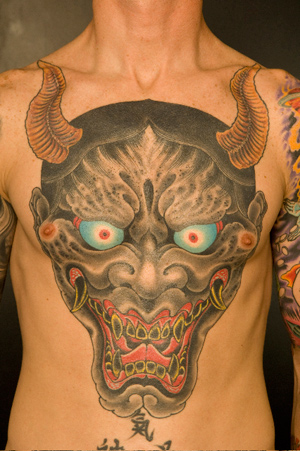 |
| Mike Rubendall / © Cuff |
Except it was luckier than that. When he wasn’t hanging out at galleries or playing drums in his younger days, he was going to car shows, reading hotrod magazines and trying to copy the custom car designs of Ed “Big Daddy” Roth on white T-shirts with felt-tip pens. He had experience dealing with insular communities of people who liked to go fast—motorcycles were a breeze. But Easyriders didn’t just traffic in bikes; their roster of magazines also included Tattoo and its sister publications, Flash and Savage. In 1994, Billy Tinney, the editor-in-chief and senior photographer for Tattoo, tapped him for a special assignment: To start shooting profiles of tattoo shops in Los Angeles for the magazine. It was an era, Cuff says, when tattooing was still somewhat underground. “This was before you were seeing [tattoos] on every basketball player, every football player,” he tells me, “and way before things like Ed Hardy shirts and Affliction.
“I thought to myself, ‘This is mighty…niche. I wonder where this could ever go?’”
Cuff’s first assignment was to shoot Greg James and the crew at Sunset Strip Tattoo, or, as he describes it, “baptism by fire.” He was accompanied by two other editors under the Tattoo umbrella, Frenchie Nilsen and Dave Nichols, to make sure he knew what he was doing and that he was the guy for whom they were looking. Sure enough, he didn’t freak out or soil himself or anything of the sort. And the tattoo artists? Well, they took to him quickly, too, he says. But I’m not buying it. If he’s not going to tell me his goddamn age, I figure the least he can do is give me some dirt about the vicious hazing he must have faced at the hands of these old school bad-asses…except he doesn’t budge. “I’m kind of a get-along guy,” he says with such sincere cheer that I know it has to be the truth. It’s becoming apparent that this is a guy who trades in gaining access to the famously inaccessible, and that’s the sort of station that requires either authenticity of personality or a high tolerance for fakery. After nearly two decades behind the lens, though, it strikes me that the latter would be too exhausting to cling to.
With Sunset Strip Tattoo in the can, Cuff was anointed “the local guy.” He hit shops all over the city, photographing their interiors, exteriors, staff and clients, building records for each. There are only so many local shops to cover over a year’s worth of issues, though, let alone four or five years’ worth, so the magazine started sending him on the road, first to San Francisco and San Diego and Santa Barbara, and eventually to Phoenix and Portland, New York City and Boston, Hawaii and Tahiti. He learned as he went along, though he still says he wouldn’t consider himself an expert. When he went to Tahiti, he picked up a book about the history of tattooing on the island and, when taking refuge from the heat, read about the English and Russian explorers who came to the island and left with tattoos, only to be gawked at back home like circus animals. It’s in these more “exotic” locales that he typically feels more compelled to educate himself about the culture. “The more literal kind of old school, classic American-style tattoo is a little more understandable,” he says. “It has symbolism, but it’s something you grow up with. You see someone walking by with a sailor-style tattoo and you don’t think it’s that strange. With the island tattooing, I felt like I had to study it a bit more.”
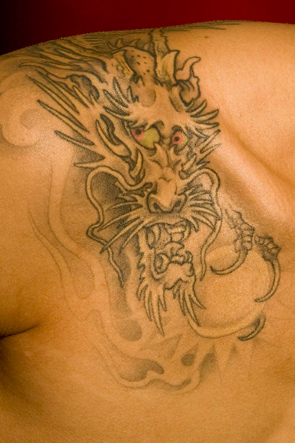 |
| The Dutchman / © Cuff 2009 |
One of his greater thrills was getting the chance to photograph The Dutchman and his Dutchman Tattoos Studio and Gallery in Burnaby, British Columbia, a few years ago—partially due to admiration, but also because no one had photographed the artist in years. “He pointed to an old article on the wall,” Cuff says of The Dutchman, “and said, ‘See? We’ve been done before.’ And it was from the ’80s! I was like, ‘Are you kidding me?’”
But some of his favorite studios are back on the mainland. He raves about Mike Rubendall’s Kings Avenue Tattoo in Massapequa, New York, to which he’s made several professional visits. “The level of the artistry is just so high,” he says. “There’s never one image that comes in front of my lens where I think, ‘Oh no, how am I going to do this?’ or, ‘I’m going to delete this after I leave.’ Because that does happen.” One of Cuff’s biggest pet peeves when shooting clients’ tattoos is going home afterward, looking at the images on his computer, and realizing that someone has tried to sneak a cover-up past him.
“All power to those who can do cover-ups,” he says, “but for me it doesn’t work. I see something underneath the other image and it bothers me, especially nobody’s told me it was a cover-up.”
At this point, he’s got shop-shooting down to a science. Shops are approached far enough in advance to allow time for the artists to contact clients to come in and be photographed, and once shows up and sets up his lights, it’s all business, blowing through an average of 25 clients a day, in addition to any supplementary photos of the shop itself and staff. There are no assistants, no make-up artists, no hair dressers, so part of his success and peace of mind can hinge on the cooperation of his subjects, some of whom, he says, go above and beyond. It’s not uncommon for shops to assign counter staff to handle photo releases and other paperwork and to supply him with coffee and muffins. Beyond that, though, the ingredients for a great photo shoot are somewhat expected. “Some hot girls are always fun,” he says. “It’s always great when you see someone who has it all together. Great makeup, hair, cool clothes…it’s a great feeling and makes my job pretty easy.”
Most shops, he says, have had a convivial atmosphere during shoots, but there have been exceptions. Occasionally, he’s had shoots where he’ll take a staff photo early in the morning, and then need to take another one in the evening—because someone was fired or quit during the day. “That’s not a horrible thing for me,” he says, “but it definitely makes you think, ‘Hey, there’s some drama going on around here.’”
All of this—the travel, the education, the meetings and greetings and inside baseball—and yet, Cuff himself does not have a single tattoo of his own. Sure, he has his reasons—he’s very light-skinned and prefers long-sleeved shirts, so he wouldn’t ever show one off; he doesn’t work out assiduously and isn’t going to be flexing in the weight room with a pinup girl on his biceps—but he largely abstains because he considers himself a sort of cultural anthropologist in the tattoo world. “I’ve dropped in via photography,” he says, “and I’m documenting a world. I don’t necessarily have to participate actively to document it well.” He analogizes the fact that he doesn’t have tattoos to the common phenomenon of great fashion photographers who neither (1) dress well nor (2) walk the runway. “The idea that you have to be a motorcycle rider to shoot motorcycles,” he says, “or a tattooed person to shoot tattoos is kind of a holdover idea from the ’50s and ’60s, when the tattoo and motorcycle cultures were so underground that the only people who were interested in capturing them were from those worlds.” When Easyriders came around, however, Cuff’s focus wasn’t on becoming a biker: It was on becoming a great photographer. “I’m a beauty fiend,” he admits. “I’m not trying to expose an underbelly, and I’m not trying to get at somebody and expose their weaknesses. I’m just trying to document things in the most beautiful and flattering way I can.”
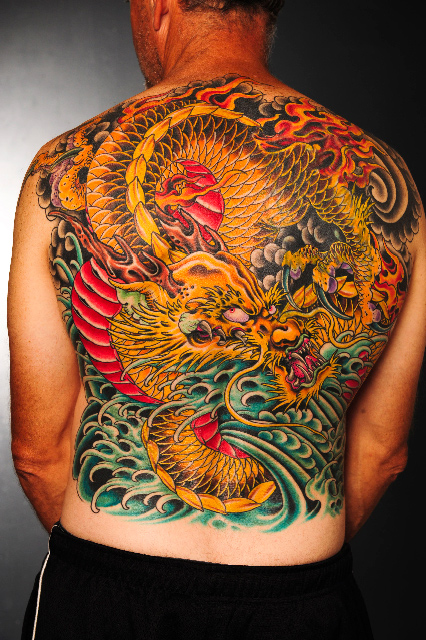 |
| Justin Weatherholz / © Cuff 2008 |
Following Cuff’s immersion into the world of tattoos, however, he’s experienced a dilemma all too common to the heavily tattooed: a relative lack of mainstream acceptance. Some photographers are able to stack their portfolios with tattoo imagery, he says, “but I don’t think if I sent in my portfolio of images and they were all loaded in that direction that I could get a job with a mainstream ad agency.” He’s approached gallery owners in Los Angeles about potential gallery showings, and has frequently been told of the catch-22 inherent in this sort of work: the people who are more likely to enjoy his work are the least likely to buy it. “It speaks to a certain crowd,” he says of tattoo imagery, “and it’s largely a younger audience, who, in general, is trying to pay their rent, trying to feed themselves, and they don’t have the kind of disposable income an older, moneyed crowd has. So if I print an image fairly large and I mount it and I matte it and frame it and I charge ‘X’ amount of money, it’s something that’s going to appeal to an older audience as far as the quality and presentation, but it’s something that a younger audience is more likely to buy…if they could afford it.”
It’s a tough spot, he admits—all the more reason to not allow himself to get stuck in one niche. As a photographer, he’d love it if people looked at his tattoo work and, in that, saw someone talented enough to do fashion or advertising, or looked at his motorcycle shots and entrusted him with a car campaign. It’s a conundrum for the photographer who worships the versatility of an Irving Penn, yet maintains, “I don’t necessarily want to sell out, I don’t necessarily want to be watered down.” The common thread through all his work, he says, is that he seeks imagery with an edge—work that speaks to what he calls a “knowing audience.” The sort of thing that can be off-putting to people in the “straight world.”
And sure enough, he has branched out: Within his portfolio is his “Wasteland” series, which focuses on broken down, dilapidated rural scenes (with some shots of Hank Williams III included for good measure), as well as some of the live concert photography he missed out on in those early days. “It’s like big-game hunting,” he says of shooting concerts. “You’ve got three songs at the front of a concert. That’s all. You get the thing in your sights and you get it…or you ain’t gonna get it.
“There’s an adrenaline rush when Madonna jumps out on stage; you’ve gotta get a charge out of what you do.”
Nonetheless, he still feels like he’s hustling to catch up and build his body of work. “It’s almost like their classic rock photography is my classic tattoo imagery,” he says of those who jumped on the photography train ahead of him, the artists close to him in age—whatever that is. “Maybe if I live to be 100,” he says, laughing, “there’ll be a retrospective.”
Wait…100? What the hell happened to 103?
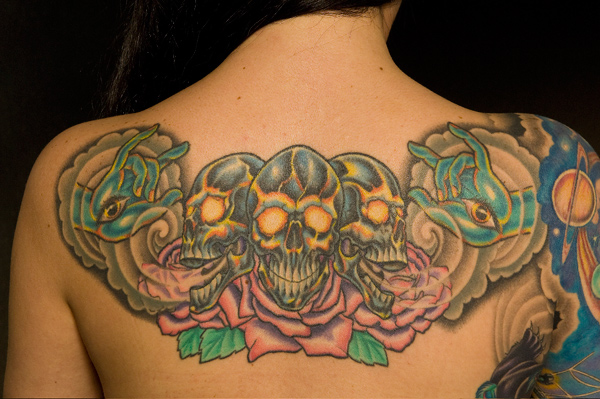 |
| Dawn Purnell / © Markus Cuff photo 2008 |
Visit Markus online at MarkusCuffPhoto.com.
Please consider buying a membership to BME so we can continue bringing you articles like this one.